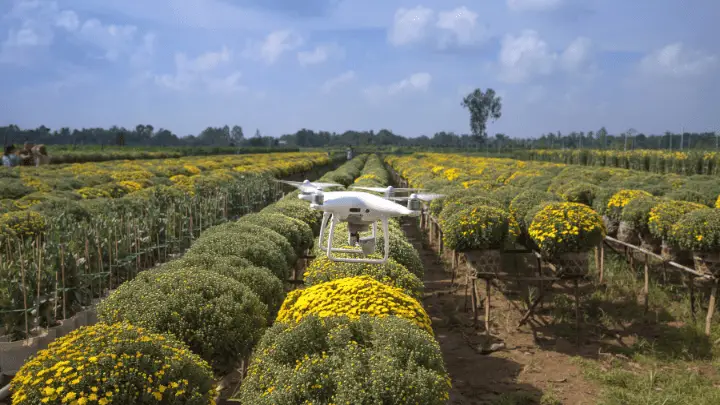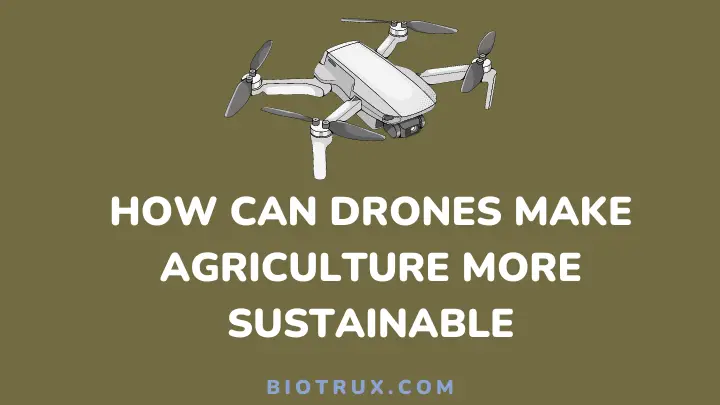Drones are no longer just a toy for hobbyists. They have become an essential tool in the agricultural industry, and for good reason. Drones have started making agriculture more sustainable.
They are now helping farmers and agronomists optimize their resource management, reduce costs, and improve crop yields. In addition, drones can help farmers make better-informed decisions, leading the way with sustainable farming practices while also protecting and increasing profitability.
With the world’s supply at an all-time high and commodity prices at an all-time low, the modern farming industry is at a crossroads. There is a greater need than ever before for farmers and agronomists across the globe to improve resource management in response to tightening budgets.
In this article, you will discover how drones can make agriculture more sustainable and how they can help farmers and agronomists meet the challenges of the 21st century.
Let’s dive in!
1. Precision Farming with Drones
Precision farming is a modern approach to agriculture that uses data and technology to optimize crop and resource management. Drones are one of the tools that enable precision farming, as they can collect and analyze various types of information.
Some information drones can collect include but are not limited to, soil quality, crop health, weather conditions, pest infestation, and irrigation needs. With the help of drones, farmers can monitor their fields more efficiently, apply fertilizers more accurately, and water where and when it is necessary.
This reduces labor costs, waste, and environmental impact while increasing crop yield and quality. According to the Food and Agricultural Organization, precision farming can increase crop yield by up to 20%.
Drones are thus reshaping agriculture by making it more sustainable and profitable.
2. Increased Efficiency and Reduced Environmental Impact
Drones can make agriculture more sustainable by increasing efficiency and reducing environmental impact. For example, drones can monitor crop health and soil conditions and apply fertilizers or pesticides precisely where needed.
In addition, drones reduce the need for heavy machinery and human labor, which can lower greenhouse gas emissions and fuel consumption. By using drones, farmers can improve their productivity, profitability, and environmental stewardship.
3. Targeted Crop Spraying and Fertilization
Drones can make agriculture more sustainable by using targeted crop spraying and fertilization. These methods reduce the amount of chemicals and water needed for farming and also minimize the environmental impact of agriculture.
Targeted crop spraying involves using drones to apply pesticides or herbicides only to the areas that need them instead of spraying the whole field. This reduces the risk of overuse, runoff, and resistance.
Targeted fertilization involves using drones to deliver nutrients to the crops that need them based on soil and plant health data. This improves crop yield and quality and reduces fertilizer waste and pollution.
By using targeted crop spraying and fertilization, drones can help farmers save money, resources, and time while also protecting the environment and human health.
4. Field Mapping and Terrain Analysis
Field mapping and terrain analysis are some of the ways drones can help farmers optimize their inputs, reduce their environmental impact, and increase their yields. For example, drones can map the variability of soil properties, such as moisture, pH, and organic matter.
These parameters can help farmers apply fertilizers and pesticides more precisely and efficiently. Drones can also analyze the topography and drainage of the land and help farmers design irrigation systems that conserve water and prevent erosion.
By using drones, farmers can adopt a more data-driven and sustainable approach to agriculture.
5. Optimized Resource Utilization
Drones can make agriculture more sustainable by optimizing resource utilization. This means using the minimum amount of inputs such as water, fertilizer, pesticides, and fuel to achieve the maximum output of crops.
Drones can collect and analyze agricultural data and provide precise recommendations for farmers to apply the right amount of resources at the right time and place. This reduces environmental damage from agriculture, such as nitrate leaking, water wastage, and greenhouse gas emissions.
For example, drones can reduce water-use efficiency by 30% and fuel efficiency by 55%. Drones can also perform tasks such as seeding, spraying, and pollination, which save time and labor costs. Therefore, drones are a key technology for sustainable agriculture in the 21st century.
6. Enhanced Crop Monitoring and Management
Drones significantly contribute to sustainable agriculture through enhanced crop monitoring and management. Equipped with advanced sensors and imaging technology, drones provide real-time data on crop health, allowing farmers to identify issues promptly.
This proactive monitoring enables precise interventions, reducing the need for excessive pesticide or fertilizer use. By optimizing resource allocation, drones enhance overall crop management, minimizing environmental impact.
For instance, drones can swiftly detect and address diseases, preventing widespread damage and ensuring healthier yields. The result is a more efficient and environmentally friendly farming approach, showcasing how drones play a vital role in making agriculture sustainable and resilient to challenges.
7. Effective Management of Irrigation
Effective management of irrigation is one of the ways drones can make agriculture more sustainable. Drone can do this by optimizing water usage, reducing water waste, and improving crop yield.
As you already know, these Unmanned Aerial Vehicles (UAVs) are equipped with sensors that can collect data on soil moisture levels and other weather-related conditions. This allows farmers to apply water more efficiently and accurately, helping them avoid over-irrigation.
By doing so, farmers can avoid over-irrigation and waterlogging, which can damage crops and the environment. According to World Bank Blogs, agriculture accounts for 70% of global freshwater consumption, which makes effective irrigation management crucial for sustainable agriculture.
Drones can help farmers save water by reducing evaporation, runoff, and deep drainage. Effective irrigation management also reduces the energy needed for pumping and distributing water, lowering greenhouse gas emissions.
By using drones for irrigation management, farmers can improve their water-use efficiency, crop yield, and profitability while reducing environmental impact.
8. Infrastructure Inspection and Maintenance
Drones emerge as crucial tools for sustainable agriculture by facilitating infrastructure inspection and maintenance. Equipped with high-resolution cameras and sensors, drones can survey vast agricultural landscapes quickly and efficiently.
This technology enables farmers to identify potential issues in irrigation systems, fences, or other critical infrastructure. By detecting problems early, farmers can implement timely repairs, preventing resource wastage and ensuring optimal functionality.
According to research, drone-based inspections can be up to five times faster than traditional methods. This not only enhances operational efficiency but also minimizes environmental impact by reducing the need for extensive manual inspections and repairs, aligning with sustainable agricultural practices.
9. Wildlife Monitoring and Habitat Assessment
Drones contribute significantly to sustainable agriculture through wildlife monitoring and habitat assessment. Equipped with advanced cameras and sensors, drones provide a non-intrusive means to survey ecosystems, aiding in the conservation of biodiversity.
Real-world applications include tracking wildlife patterns, identifying potential threats, and assessing the impact of agricultural practices on local ecosystems. By promoting a harmonious coexistence between farming activities and wildlife preservation, drones foster sustainable agricultural practices.
This proactive approach not only safeguards biodiversity but also ensures a balanced and ecologically sound farming environment. This showcases the multifaceted role of drones in agriculture’s sustainable future.
10. Research and Training
Drones play a pivotal role in fostering sustainable agriculture through research and training initiatives. These unmanned aerial vehicles provide a cost-effective and efficient means for agricultural research.
It facilitates data collection on soil health, crop varieties, and climate patterns. Additionally, drones are instrumental in training farmers on modern, sustainable practices.
Real-world examples include agricultural extension services utilizing drone technology to educate farmers on precision farming techniques. By integrating drones into research and training, agriculture becomes more informed, adaptive, and sustainable, ensuring the industry’s resilience and environmental stewardship.
What is the Future Outlook for Drones in Sustainable Agriculture?

The future outlook for drones in sustainable agriculture is highly promising. As technology continues to advance, drones are poised to become integral to precision farming, resource optimization, and climate-resilient practices.
Anticipated innovations include enhanced sensor capabilities, AI-driven data analysis, and increased automation, ensuring more precise and efficient farming operations. Drones will likely play a crucial role in addressing global food security challenges by optimizing resource utilization and minimizing environmental impact.
Moreover, ongoing research and development suggest that drones will contribute to evolving sustainable farming practices, adapting to climate changes and fostering biodiversity. The trajectory indicates a future where drones become indispensable tools, shaping the agricultural landscape toward greater sustainability and resilience.
FAQs
How do drones contribute to sustainable agriculture?
Drones contribute to sustainable agriculture through precision farming, enhanced crop monitoring, and optimized resource utilization. Their ability to provide real-time data empowers farmers to make informed decisions, promoting efficient and eco-friendly practices.
Are there any environmental benefits of using drones in agriculture?
Yes. Drones reduce the environmental impact of farming by minimizing manual labor, optimizing resource usage, and promoting sustainable practices. They contribute to a more eco-friendly and efficient agricultural ecosystem.
What challenges do farmers face in adopting drone technology?
Farmers encounter challenges such as technological barriers, connectivity issues, and regulatory concerns when adopting drone technology. Overcoming these hurdles is essential for the widespread integration of drones in agriculture.
Can drones help in climate-resilient agriculture?
Yes. Drones have the potential to enhance crop diversity and contribute to climate-resilient agricultural practices. By providing valuable data, they enable farmers to adapt to changing climatic conditions and build resilient farming systems.
How do drones optimize resource utilization in agriculture?
Drones optimize resource utilization by precisely monitoring and managing resources such as water and fertilizers. Their real-time data allows farmers to minimize waste, increase efficiency, and promote sustainable agricultural practices.
Wrapping Up
In conclusion, drones have the potential to revolutionize the agricultural industry. They can help farmers and agronomists optimize their resource management, reduce costs, and improve crop yields.
Drones can also help farmers make better-informed decisions, leading the way with sustainable farming practices while also protecting and increasing profitability. By using drones, farmers can reduce the amount of water, pesticides, and fertilizers they use, which in turn reduces the environmental impact of agriculture.
Drones can also help farmers identify areas of their fields that need more attention, allowing them to target their resources more effectively. With the world’s population expected to reach 9.7 billion by 2050, the demand for food will only increase.
Drones can help farmers meet this demand while also ensuring that agriculture remains sustainable for future generations. So, let’s embrace this technology and work together to create a more sustainable future for all.
You can also learn more about ways to support sustainable agriculture.
Thanks for reading.
